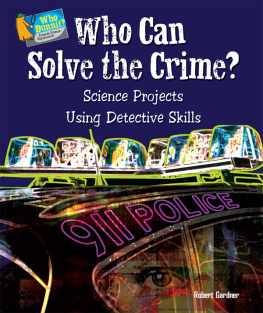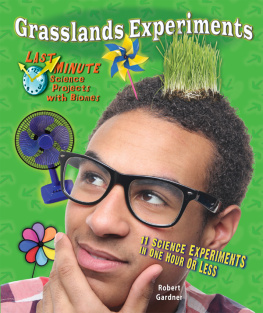No Energy to Spare?
Have you waited until the last minute to start your science project? Don't worry! Award-winning author Robert Gardner has you covered. Each energy experiment follows the scientific method, and can be completed in one hour or less. Many experiments also include ideas for more detailed science fair projects, in case you have more time than you originally thought!
"This is a great collection of simple physics experiments! They are easy to grasp, yet focus on fundamental concepts of energy, its different forms, and energy conservation, which are central to modern physics."
Stanislav Sazykin, Senior Faculty Fellow
Physics and Astronomy Dept., Rice University
About the Author
Robert Gardner is an award-winning author of science books for young people. He is a retired high school teacher of physics, chemistry, and physical science. In 2010, he received the Lifetime Achievement Award in Hands-On Science Writing from AAAS/Subaru Science Books & Films.

Do you have a science project due tomorrow and youve put it off until now? This book provides a solution! Here you will find energy experiments that you can do in one hour or less. In fact, some of them can be done in 30 minutes, others in 15 minutes, and some in as little as five minutes. Even if you have plenty of time to prepare for your next science project or science fair or are just looking for some fun science experiments, you can enjoy this book, too.
Most of the experiments are followed by a Keep Exploring section. There you will find ideas for projects or experiments in which the details are left to you. You can design and carry out your own experiments, under adult supervision, when you have more time.
Sometimes you may need a partner. Work with someone who likes to experiment as much as you do so you will both have fun. Please follow any safety warnings and work with an adult when it is suggested.
This is a book about energy, and energy is related to work. So you need to know how a scientist defines work. To a scientist, work is a force times a distance. If you lift a 10-pound weight to a height of 3 feet, you do 30 foot-pounds of work because:
10 lbs x 3 ft = 30 ft-lbs.
If you are using the metric system and lift a 10-newton weight through a height of 2 meters, the work you do is 20 newton-meters because:
10 N x 2 m = 20 N-m, or 20 joules.
Different sciences use different ways of experimenting. Depending on the problem, one method is likely to be better than another. Designing a new medicine for heart disease and finding evidence of water on Mars require different experiments.
Even with these differences, most scientists use the scientific method. This includes: making an observation, coming up with a question, making a hypothesis (a possible answer to the question) and a prediction (an if-then statement), designing and conducting an experiment, analyzing results, drawing conclusions, and deciding if the hypothesis is true or false. Scientists share their results. They publish articles in science journals.
Once you have a question, you can make a hypothesis. Your hypothesis is a possible answer to the question (what you think will happen). For example, you might hypothesize that doing work on metal can create heat.
In most cases you should do a controlled experiment. This means having two groups that are treated the same except for the thing being tested. That thing is called a variable. To test the hypothesis above, you might have two weights each connected to a fishing line wrapped around an aluminum cylinder a meter above a floor. A thermometer in each aluminum cylinder could measure temperature. You would let one weight fall to the floor doing work on the cylinder. You would see the temperature of the cylinder rise as the fishing line rubs on the aluminum. The other cylinders temperature would not change. You would say that your hypothesis is true.
The results of one experiment often lead to another question. Or they may send you off in another direction. Whatever the results, something can be learned from every experiment!
All of the investigations in this book contain ideas that might lead you to a science fair project. However, judges at science fairs do not reward projects or experiments that are simply copied from a book. For example, a diagram of a steam engine would not impress most judges; however, a unique method of showing that energy is conserved would be likely to gain their attention.
Science fair judges tend to reward creative thought and imagination. It is difficult to be creative or imaginative unless you are really interested in your project. Therefore, try to choose an investigation that excites you. And before you jump into a project, consider, too, your own talents and the cost of the materials you will need.
If you decide to use an experiment or idea found in this book for a science fair, find ways to modify or extend it. This should not be difficult. As you do investigations, you will get new ideas. You will think of questions that experiments can answer. The experiments will make great science fair projects because the ideas are your own and are interesting to you.
Your notebook, as any scientist will tell you, is a valuable possession. It should contain ideas you may have as you experiment, sketches you may draw, calculations you make, and hypotheses you may suggest. It should include a description of every experiment you do, the data you record, such as voltages, currents, resistors, weights, and so on. It should also contain the results of your experiments, graphs you draw, and any conclusions you may be able to reach based on your results.
- Do any experiments or projects, whether from this book or of your own design, under the adult supervision of a science teacher or other knowledgeable adult.
- Read all instructions carefully before proceeding with a project. If you have questions, check with your supervisor before going any further.
- Always wear safety goggles when doing experiments that could cause particles to enter your eyes. Tie back long hair and wear shoes that cover your feet completely.
- Do not eat or drink while experimenting. Never taste substances being used (unless instructed to do so).
- Never let water droplets come in contact with a hot lightbulb.
- Never experiment with household electricity. Instead, use batteries.
- Use only alcohol-based thermometers. Older thermometers may contain mercury, which is a dangerous substance. If you have a mercury thermometer in the house, ask an adult if it can be taken to a local thermometer exchange location.
- Maintain a serious attitude while conducting experiments.
- At the end of every activity, clean all materials used and put them away. Then wash your hands thoroughly with soap and water.

Here are energy experiments that you can do in one hour or less. You dont have any time to lose, so lets get started!
Lets see how energy changes from one form to another.
- black or colored Super Ball
- smooth wood, tile, or concrete floor
- meter or yardstick
- a partner
- pen or pencil
- notebook
- white flour
- Place a Super Ball on a smooth wood, tile, or concrete floor. Lift the ball to a height of one meter or one yard. You did work on the ball. You gave it potential energy due to gravity (PEG).





















